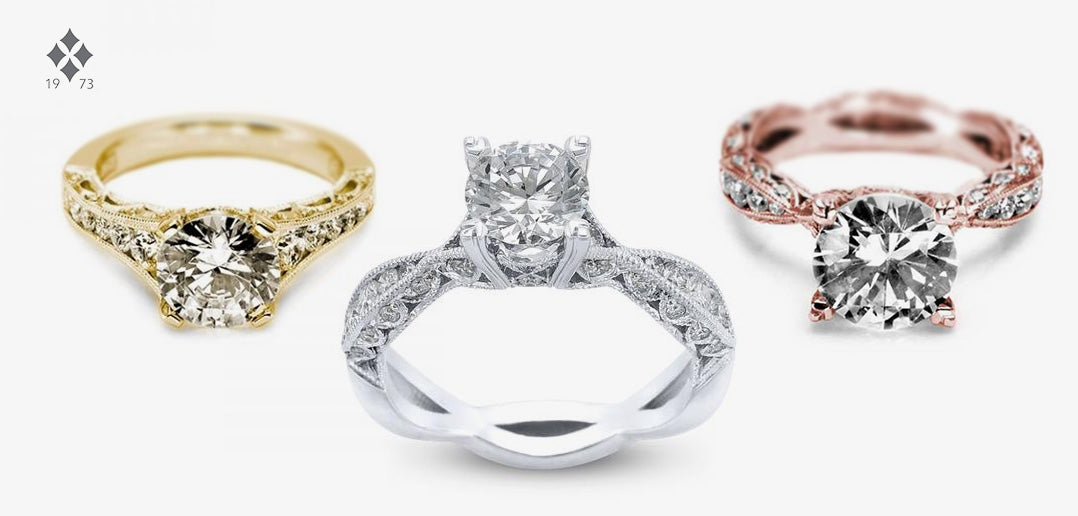
Choosing the right metal for an engagement ring is just as significant as the diamond or gemstone it will hold. We have compiled our top tips to assist you in selecting the right metal for the perfect engagement ring for your bride-to-be.
When the time has finally arrived to buy the engagement ring there are so many aspects to reflect upon. Selecting the metal alone can be a more difficult decision than it used to be with many choices now available. Where it once was a humble choice between yellow and white, now you have a whole variety of options to consider, including:
- What's the difference between white gold and platinum?
- What exactly is rose gold?
- What's going to be the "strongest" metal?
If you take this one step at a time you will end up with a ring that suits her style and that you will both treasure for the rest of your lives.
What's her style?
Firstly, pay attention to your fiancée's style. With a little investigation concluding on the right metal and colour to flatter that style will be lot easier. One of the primary things you need to think about when picking a metal for an engagement ring is the type of jewellery your future bride typically wears:
- If she’s drawn to cooler hues and silver-toned jewellery, then platinum or white gold is the way to go.
- If she rarely wears jewellery, or prefers an elegant timeless look, then platinum would be a great choice.
- Yellow gold or rose gold are good choices if she tends to gravitate toward warmer tones.
- Mixing metals like white gold and yellow gold is a great combination and allows flexibility (see our previous blog on the stacking rings trend). This option will allow her to complement any piece in her existing jewellery wardrobe.
- Depending on the design of the ring you choose, you can incorporate two different metal colours to create a unique and interesting look.
Platinum


Platinum is a naturally white metal that showcases the brilliance and sparkle of diamonds. It’s a popular choice for engagement rings and wedding bands, and is deemed the most exquisite of all jewellery metals.
Compared to gold, platinum is five times as rare and purer when used in jewellery.
Platinum is long-lasting and resilient, making it a great choice if your fiancée leads an active lifestyle — its density offers a secure setting for diamonds and gemstones.
Platinum is also naturally hypoallergenic, so it’s a wonderful choice for those with sensitive skin.
Its elegant sheen will not fade or change color over time, making re-plating your platinum ring unnecessary. Because of its strength, it’s the most popular choice for setting diamonds.
Gold
Gold is an extremely versatile metal, and a common choice for jewellery. The standard measurement of gold is a carat, which is divided into 24 parts. Pure gold is 24 carats, meaning 24 out of 24 parts are gold.
Pure gold is too soft to be used for jewellery, so it’s combined with other metal alloys to increase its strength. You’ll find 22K gold, but most often gold comes in 18K (75% gold), 14K (58% gold) and 10K (about 42% gold). The remainder is made up of other metals — silver, copper, nickel and zinc — to lend strength and durability. The type and percentage of metal alloys used determine the shade and colour of gold. For example, 22K gold tends to be a rich, saturated gold colour, while 14K gold may appear as a slightly paler yellow.
Gold jewellery usually comes in these colours:
YELLOW GOLD

Classic yet fashionable, yellow gold achieves its warm patina from the red of copper and the green hue of silver. Yellow gold lost favor to white gold for a while, but has recently regained popularity.
WHITE GOLD

More contemporary than yellow gold, white gold gets its silvery white character from combining yellow gold with copper, zinc and nickel (or palladium). It’s plated with a hard element called rhodium (a platinum group metal), which costs about four times as much as platinum, resists scratches and tarnishing, and gives white gold a reflective appearance. However, it may wear away over time, requiring a quick trip to your jeweller for re-plating.
ROSE GOLD

Unique and romantic, rose gold has a warm, pink hue created by combining yellow gold with a copper alloy. The overall percentages of metal alloys are the same for rose gold as they are for yellow or white; it’s just a different mixture of alloys used.
Now that you recognise the variances between metals, it’s time to put the pieces together.
Choose your metal, pick your design and finish the look with a vivid Mayfair diamond or gorgeous gemstone. In the process, you’ll learn things about your future wife that you may not have identified about her before — and that’s part of the excitement! In the end, you will create an engagement ring that’s just as unique and stunning as the woman who will be wearing it.

